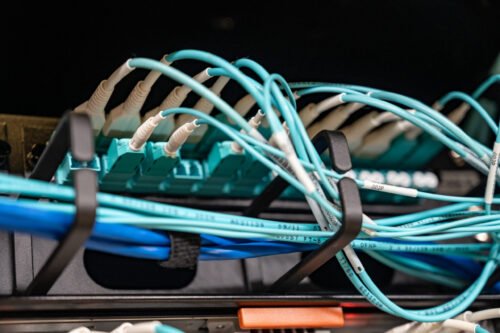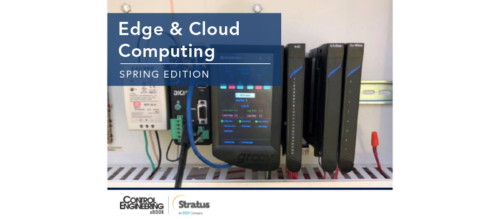On the edge: Smartening up sensors
Edge computing makes sensors smarter to use in many manufacturing applications. See five manufacturing use cases for edge processing and three edge computing benefits.
Learning Objectives
- Consider five manufacturing use cases for edge processing.
- Review edge computing benefits: Faster, less cost, security.
- See how edge computing can use vibration sensors and I/O modules.
Edge computing has attracted a lot of attention in the past five years from diverse markets – including in industrial segments undergoing digital transformation. Rapid advances in communication and computing capabilities have enabled faster adoption of edge computing in industrial markets. With this, it has become critical to define where “edge” is. Over the years, deliberations on this topic have led to a general convergence that edge should be viewed logically instead of associating it with a physical device. In a white paper by the Industry IoT Consortium, an attempt was made to depict a time-value notion of edge processing as Figure 1 shows.
Five manufacturing use cases for edge processing
A few industry use cases show applicability for edge processing in manufacturing applications:
- A standard two-three wire thermocouple is measuring the temperature of a pump. The data processing involved and the subsequent pump turn off is undertaken remotely. What is the probability of a delayed action, resulting in unscheduled pump shut down and other problems? Can this be effectively solved by an edge solution?
- The operator of a computer numerical control (CNC) machine is worried about identifying abnormalities during operation. The Plant Manager requires a no-touch solution for these abnormal vibrations.
- A manufacturer has an old stamping machine and wants to count the number of operations. He has tried several retrofit solutions including limit switches and is looking for a more elegant solution.
- Monitoring safety in critical or hazardous zone using cameras to avoid accidents, which needs real-time response to shut down the machines operating in the area.
- A process plant has a changeover process during which the color of the base material is checked for neutrality. The current methods used are of offline laboratory-based measurements or time-based decisions.
In all of the above cases, there is a huge potential to use edge processing. As sensor technology develops further, it can pave the way for signal and data processing within the sensor, resulting in smart sensors. Alternately, sensor data can be processed in close proximity to the sensor and enable real-time processing, resulting in alerting possibilities.
Edge computing benefits: Faster, less cost, security
Three benefits of edge computing worth emphasizing are:
- Deterministic response time: If a sensor can predict an unscheduled downtime, then the system has to be deterministic enough to react to the situation to prevent damage. Also, it can be unsafe if lag occurs during transmission of data over longer distances. These can be prevented with the use of edge.
- Reduced cloud cost: Most of the output generated from sensor data is time-series data, which is relatively large in certain cases. Storing and processing this data in cloud involves a huge amount of cost. With edge computing, this data can be captured and analyzed, and summarized before it is sent to the cloud, which can help reduce unnecessary cost.
- Security and data sovereignty: With smart sensor and edge processing, raw data need not travel long distance and hence it results in better security and data sovereignty by design. At the same time, handling of data by different devices might not be as secure as a centralized system, thereby leading to potential security issues. Hence a careful examination of security vulnerabilities and mitigation techniques are necessary while designing the system with edge processing.
Smart sensors, industrial applications
Sensors emit an electrical signal when subjected to physical and environmental change like temperature, pressure, light and vibration. This signal is converted to data after signal condition and processing. After running relevant algorithms, this data can become knowledge. This process is done with additional circuitry as a subsystem.
With advancements in semiconductor industry and sensor technology, the signal processing to decision-making process can be implemented on a SoC (system on chip), thus reducing cost and potentially consuming lower power. These devices, with the ability to make decisions and communicating useful information, are called smart sensors.
The block diagram shows the internal contents of a smart sensor.
Vibration sensor, I/O modules
MEMS-based smart sensors are available with extended features at a very low cost. One such example is of vibration sensor, which provides signals to indicate occurrences, such as double tap detect and threshold detect. With these available features, input/output (I/O) modules receive ready information and are exempted from extra signal processing.
Motors are a key asset in the process industry and need periodic maintenance to prevent failures and unscheduled shutdown. By installing smart sensors, the health of these assets can be regularly monitored. If the noise levels cross the threshold level, smart sensors will trigger an event to I/O controller to take an action on current ongoing operations like reducing the RPM, reduce the load on that motor or turning off the motor. Such a predictive maintenance system is both infrastructure and cost efficient.
Some radar-based smart sensors can detect objects or people entering a hazardous zone. These sensors are smart enough to measure the speed of the object and angle of arrival, which omits the need for an additional signal processing algorithm. As soon as the object enters the hazard zone, the smart sensor will send out an I/O signal, which can be directly fed to I/O module, which will in turn take the necessary action and shut down the machinery in the hazardous zone.
Edge processing
While smart sensors represent the next generation of technology, many sensors used today need external processing. This is because of the non-ubiquitous nature of smart sensor availability as well as the associated cost. A major trend that has emerged in the industry is of zero-touch sensing: video, audio and olfaction (sense of smell) represent some of these needs.
For example, can the vibrations of a system be detected by analyzing video feeds taken at high sampling rate instead of the traditional accelerometer? This would need edge processing with reasonably high computing power. Currently, GPU-based devices enable such processing.
Organizations are undergoing rapid, disruptive operational changes after automating facilities with edge computing and smart sensors. With these technologies, companies can monitor overall equipment effectiveness and use predictive maintenance tools to detect and fix potential problems, thereby enabling real-time asset tracking and increased visibility. The industrial environment is constantly evolving and its resilience relies on data for effective and efficient decision-making. Edge plays an important role and as the edge ecosystem matures, other technologies also will benefit immensely.
Shashidhara Dongre is CTO office and McNally Bethapudi is specialist, building technology and smart infrastructure, L&T Technology Services. Edited by Mark T. Hoske, content manager, Control Engineering, CFE Media and Technology, mhoske@cfemedia.com.
KEYWORDS: Smart sensors, edge computing, I/O modules
CONSIDER THIS
Are your applications using edge computing to enhance sensor use?
Do you have experience and expertise with the topics mentioned in this content? You should consider contributing to our CFE Media editorial team and getting the recognition you and your company deserve. Click here to start this process.





